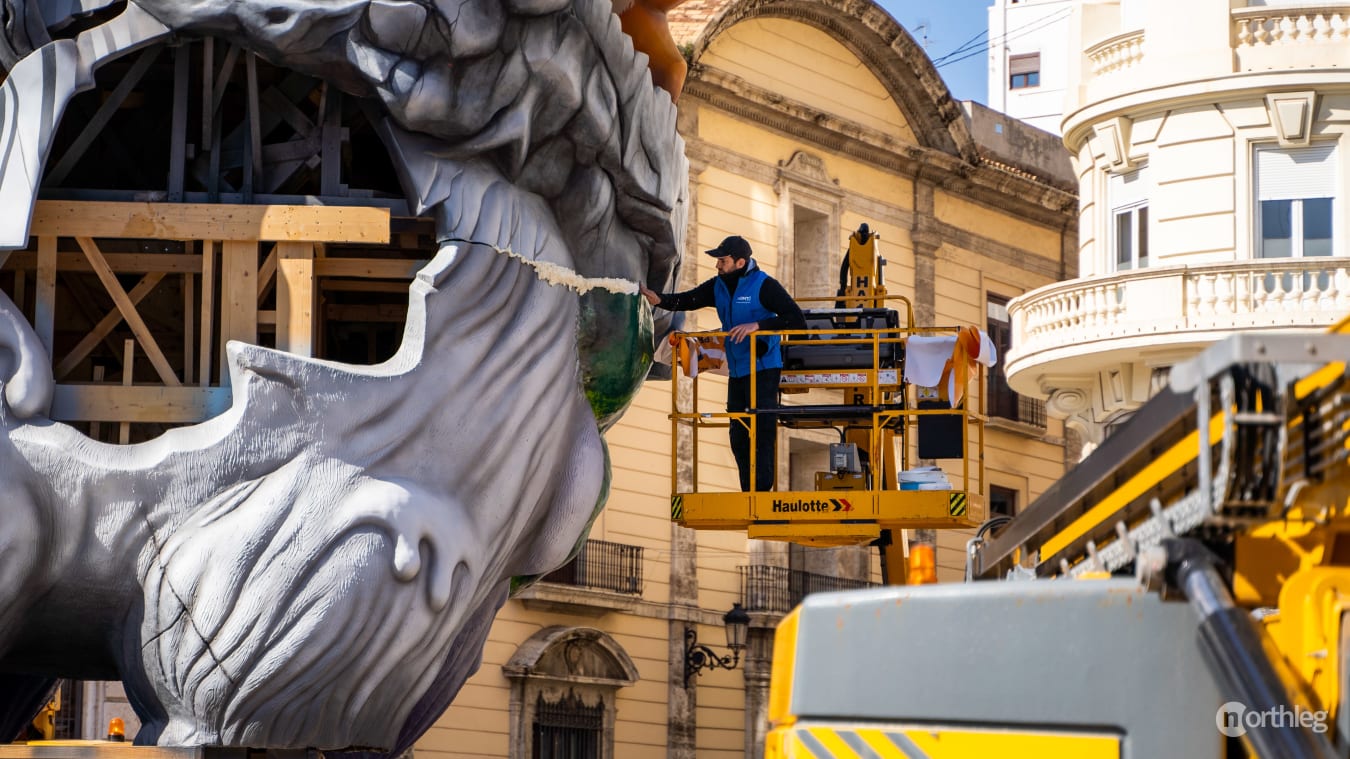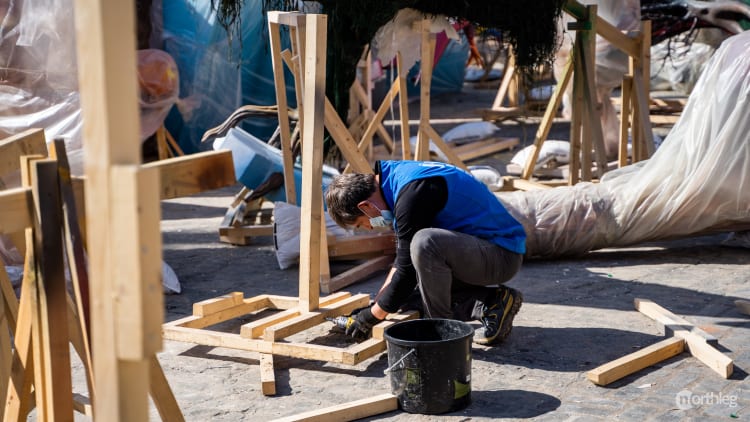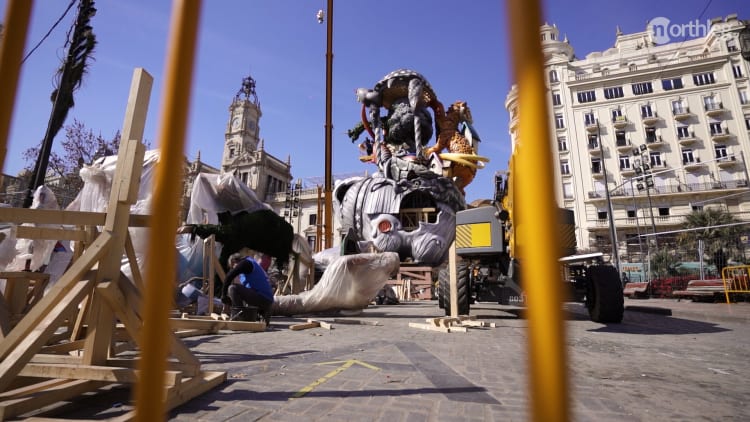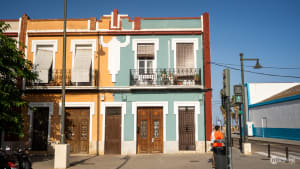
Plantà
The feat that opens the final and most spectacular act of the Fallas festival. The moment when the sculptures are finally presented to the city.
The Plantà in a nutshell…
The Plantà marks the moment when Valencia’s Fallas sculptures are fully assembled and revealed to the public. It signals the start of the festival’s final days, turning the city into an open-air gallery before the fiery conclusion.
Dates: Children’s fallas must be completed by the morning of March 15, while the larger fallas have until the morning of March 16.
Best time to watch: The night before each deadline, when falleros work through the night adding final touches. Some of the largest fallas begin assembly up to 10 days earlier.
Larger sculptures require cranes for assembly, while smaller ones are raised manually in the Plantà al tombe tradition. Once erected, fallas are secured with sandbags or cement blocks to prevent collapse.
The Plantà (or Plantá in Spanish) is the act of putting up a falla in the city for everyone to see. This event is long awaited in Valencia, as it marks the beginning of the Fallas festival’s final days, at the end of which the sculptures will be burnt.
The term Plantà, which comes from the verb plantar (to plant), has been historically used for the entire act of erecting a falla in the city, from beginning to end. However, in the present day, this act doesn’t always happen in one go, and might actually take more than a few days. So we can say that now the word only really refers to the final act of a falla’s arrangement.
After the Plantà the wood and papier-mâché compositions are considered complete and ready to be assessed by the judges, they cannot be modified or adjusted. They are supposed to have all their components, ornaments, ninots, and explicatory signs in place.

Since there are two main categories of fallas (fallas mayores for adults and fallas infantiles for kids), there also are two Plantà events.
The Plantà infantil comes first, and it is usually the quicker of the two. In one night, all sculptures of this category are set up in the city, ready to be judged on the morning of the 15th of March. The fallas mayores’ arrangement can take quite a few days, depending on the size of the monument. However, the sculptures all have to be ready for the judges by the 16th.
The Plantà is a special moment of this festival, it is the event that puts an end to all the construction, assembly and working on the fallas. It is a bittersweet moment. People, both Valencians and visitors, will soon come out in the streets and admire the completed fallas. And that means that soon after the Cremà and its bonfires will come; the year’s cycle is coming to an end.
But it is also a time of coming together for all the artists, falleras, and falleros who put all their energy and hard work into making the sculptures. The night before the Plantà, excitement can be felt and heard in the streets of Valencia, the air is charged with trepidation and anticipation. Just like the last rehearsal before a play, all the people involved will come together and work together through the night to assemble these spectacular pieces.
How it’s done
The fallas are pretty much already complete in the artists’ workshops by the time of the Plantà. The sculptures made of wood, cardboard, cork and papier-mâché are built and painted weeks before.
However, in order to be transported to the chosen spot in the neighbourhood, they need to be disassembled (especially in the case of the bigger fallas), put in large trucks, and reassembled on site.

Cranes
In the case of the bigger fallas, usually the fallas mayores (adult fallas), falleros need to use cranes to put them up piece by piece. Normally, they will start from the central body (the bigger and main one) and the lateral bases. After that, they will add the various ninots (the smaller figures) that decorate the composition.
These ninots, lighter in weight, are normally secured and nailed with wooden sticks. Other additions like signs that explain the falla to the public are also put up last.
After the bulk of the work is done, it’s time for the finishing touches. The various falleros check if the paint has been ruined and retouch it if needed, as well as add some final ornaments.
Al Tombe
There is also another way to put up the fallas that doesn’t involve cranes. It is way more theatrical, but it can only be done with the smaller fallas, like the fallas infantiles (fallas for children). This technique is called plantà al tombe.
After being taken out of the truck, the falla is put on the ground, lying down. From there, several falleros will leverage one side or the other and prop the sculpture up. This is done without the use of any machine, just with the strength of the people and the help of ropes in case of a bigger sculpture.
Safety procedures
Independently of the size, there are always safety procedures that need to be respected.
First of all, the site where the falla will be set up is prepped. This means that sand is placed on the ground to avoid damage to the pavement or asphalt when the falla burns in the Cremà. Despite the precautions, it is not uncommon for asphalt to melt with the heat of the bonfires.
Due to the size of the sculptures, which can reach up to 20 metres in height (65 feet), the next step is making sure the fallas won’t topple over under their own weight or the wind. This is achieved through the use of sandbags and cement blocks (in most cases), or even cement bases (only in rare cases).
Schedule
There really are two different Plantàs, the first one for the children’s fallas and the second for the fallas mayores.
| Type |
|---|
| Act of the Plantà |
| Deadline |
One to ten days
In the past, the sculptures were simple and small enough that they could be transported and put up completely on the day of the Plantà. However, with the evolution of the materials, techniques, and skills of the artists, they have become increasingly complex and voluminous.

This means that the larger fallas need much longer preparation. If you’re around Valencia on the days preceding the Plantà, you are likely to see the bigger fallas already being set up (up to 10 days before).
The deadline
The deadline indicates the time when judges will come to assess the sculptures and determine the various prize winners. To meet these deadlines the various artists and falleros will meet the night before, eat together in often improvised dinners, and get to work on the finishing touches at midnight.
In many cases, not even this official starting time is respected because the same artist tends to work on many fallas, and they will need time to visit them all. This means that sometimes, at 9:00 or 10:00 am on the 16th, you still might see the falleros completing their work.
Frequently Asked Questions
Here you can find quick answers to all of your questions. Linked, you’ll find the articles or the sections of the articles that can give you more detailed information.
-
The Plantà is the act of putting up the fallas sculptures.
-
The Plantà of the adult fallas is between the 15th and 16th of March. They have to be ready by the morning of the 16th.
For the fallas infantiles, it’s a day early: they have to be ready by the morning of the 15th of March.
-
For the smaller fallas, yes, for the bigger ones, no. In fact, the process to put up the biggest fallas will start up to 10 days before the Plantà.
-
Not always. Sometimes, the same artist works on more than one falla, therefore needs more time to finish setting up everything.
You can read more about this in the relevant section of this article.
-
The fallas are put up by the artists themselves and the various Falla committees members, the falleros.
-
Depending on the size of the falla sculpture, they are either assembled piece by piece with the help of a crane, or by hand in al tombe technique.
If you’d like to know more about how the sculptures are put up, you can check the relevant section of this article.
-
Of course. First of all, the ground where the fallas are to be erected is prepped. This means that sand is placed there to avoid damages to the asphalt.
Then, when the fallas are put up, they are secured with sandbags or cement blocks to prevent them from toppling over.
If you’d like to know more about this, you can check the relevant section of this article.
-
The Plantà infantil comes first, as it is usually the one that takes less time. The fallas infantiles have to be ready by the morning on March 15th, while the fallas mayores have until the 16th.
You can learn more about the Plantà’s schedule in the relevant section of this article.
-
The fallas are built in the artists’ workshops. Then, during the Plantà, they are moved to the streets of Valencia.
-
Some of the bigger fallas can reach up to 20 metres in height (65 feet). These are the fallas that will take the longest to assemble.



















